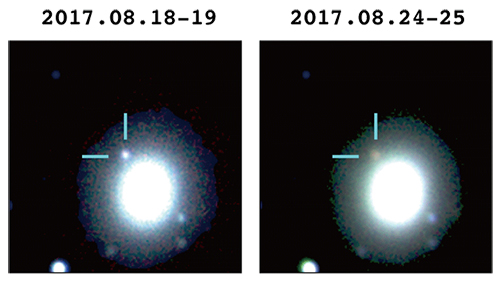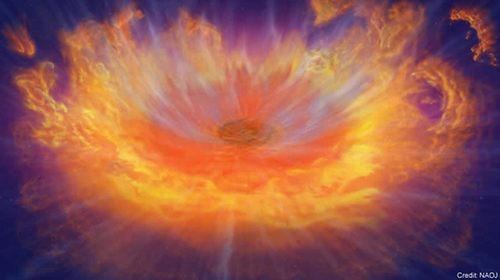News
Japan team Succeeds in Capturing Source of Gravitational Wave with Light Updated in November 2017
This year's Nobel Prize in Physics went to three researchers from the United States for their successful observation of the “gravitational wave.” However, they did not actually see the preceding astronomical phenomenon which triggered the gravitational wave. It was estimated that gravitational wave came in to existence through "the coalescence of two black holes." However, on October 16, Japan’s tracking team consisting of Hiroshima University, National Astronomical Observatory of Japan (NAOJ) and University of Tokyo announced that they were able to identify that the collision of two neutron stars had triggered the gravitational wave. The team did so by observations using optical light and infrared light. It was the first time in the world that the origin of graviational wave was confirmed with such electromagnetic waves.
On August 17, this gravitational wave was captured by the United States’ detector LIGO and its European counterpart Virgo. The LIGO-Virgo team immediately announced to the world that the graviational wave observed this time was due to a whole different astronomical phenomenon. Light does not emerge when black holes collide. In response to this, the team in Japan began observing with various telescopes including NAOJ’s Subaru Telescope located in Hawaii.
From analyzed data, it became evident that there were many electronmagnectic waves of different wavelengths which triggered the gravitational wave of Auguts 17. The cause was traced back to the characteristic of merging neutron starts rather than the collision of black holes. Neutron stars are extremely dense. For every 1 cubic centimeter it weighs 1 billion ton. In theory, it was already estimated that gravitational waves would emerge through coalescence of neutron stars.
Details of the coalescence or merging were also clarified. The neutron star’s distance from the earth is 130 million light-years. The observed optical light weakened day by day since the gravitational wave arrived. Contrarily, the infrared light did not diminish. Should a kilonova reaction occur from the merging of neutron stars, the amount of optical or infrared light would follow such patterns of decrease. And such patterns were actually observed. Kilonova is a phenomenon where heavy elements like gold, platinum, or rare earth materials are born due to merging of neutron stars.
In the past, heavy elements like gold and platinum were thought to emerge from “supernova explosions” caused by stars coming to the end of their life cycles. In recent research however, this is no longer believed to be probable. Confirmation of the merged neutron stars is said to bring us closer to understanding the origin of heavy elements.
Besides observation of gravitational waves, efforts across many different fields were involved in this research. Observation of optical light/infrared light, gamma rays, theoretical research of star-generation and so forth contributed in overall results. This phenomenon was also captured by many telescopes around the world. The LIGO-Virgo team announced that the results were possible due to collaboration by astronomers around the world. We can say that this new field of astronomy is definitely taking root for growth.
https://www.nao.ac.jp/en/news/science/2017/20171016-j-gem.html
https://www.unawe.org/kids/unawe1730/

(Provided by NAOJ and Nagoya University)








